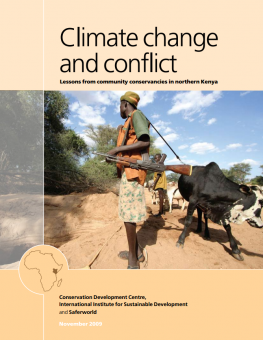
Climate Change and Conflict: Lessons from community conservancies in northern Kenya
This report is based on the findings of research carried out in two community wildlife conservancies in northern Kenya earlier this year.
This report is based on the findings of research carried out in two community wildlife conservancies in northern Kenya earlier this year.
It illustrates how climate change is affecting the distribution and prevalence of natural resources in Kenya, but makes it clear that this is not the only factor contributing to resource scarcity. It emphasizes that competition for natural resources is a key driver of conflict, but also that it interacts with a range of other factors and that violence is not inevitable. The research found that local governance mechanisms, especially natural resource management mechanisms, provided by community conservancies in the region, are crucial in determining whether competition over scarce resources will turn into violent conflict.
Participating experts
You might also be interested in
CSC Stories: Restoring the Lake Edward Fishery in Virunga National Park
A short profile of efforts by IISD and the Wildlife Conservation Society to address the impacts of conflict on the Lake Edward fishery in Virunga National Park in the eastern Democratic Republic of Congo.
CSC Stories: Developing Conflict-Sensitive Management Strategies in Public-Private Conservation Concession in the Amazon
A short profile of efforts to reduce social conflicts around the Los Amigos Conservation Concession in the Peruvian Amazon by incorporating the conflict-sensitive conservation approach into conservation planning and strategies.
CSC Stories: Supporting Community Conservation in Kahuzi Biega National Park
A short profile of work by IISD and the Wildlife Conservation Society to reduce people-park conflicts by strengthening community involvement in conservation strategies in Kahuzi Biega National Park in the eastern Democratic Republic of Congo.
Conservation and Peacebuilding in Sierra Leone
The aim of this paper is to assess the status of conservation in Sierra Leone, to outline some of the key threats to protected area management in the country and try to understand how to manage protected areas in a way that does not create or exacerbate tensions and conflicts.